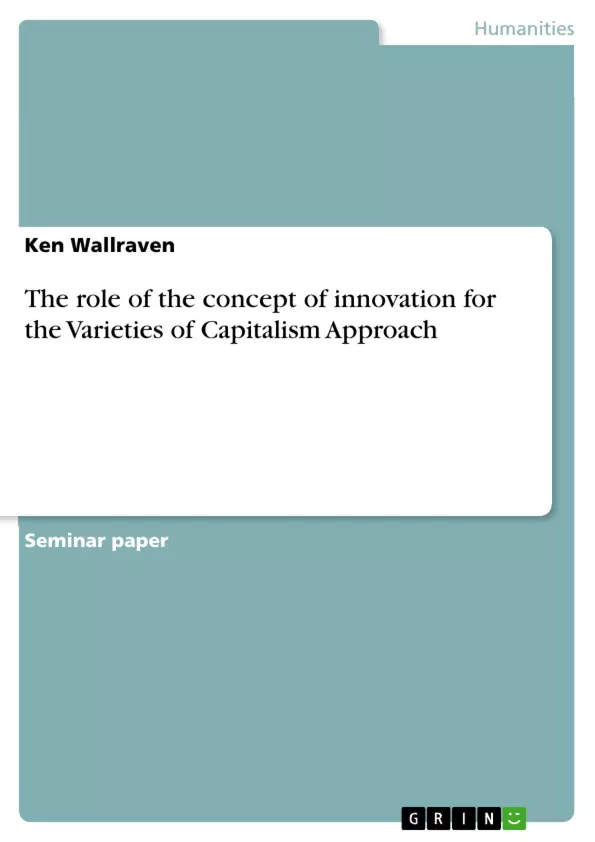What has happened to the „European Dream“ - the dream of becoming a plural unity with one constitution? After the debris, following the French “NON!“ and the Dutch „NEE!“ on the EU-referendum we can see clearly, how national preferences in instiution making diverge. Now, alternative plans are taken out of the drawers. Attempts to mobilize and to change EUcitizens opininons are being made. An interesting political process to watch. For this paper, I am going to analyse the character of the relationship between the basic concept of innovation and its role in the Varieties of Capitalism (VoC) approach worked out it detail in Hall and Soskice´s „Varieties of Capitalism „. Orfeo Fioretos, one of the participating authors, aims to analyze and to exemplify national preference building on another level, a more dynamic one by shifting attention to how agreements in (multilateral) institutional decision making come about. The accelerated processes of structural change often referred to as „the globalization processes“, and often understood as a neoliberal breakthrough to „all areas of life“ forces us to take a look at the situation of labour markets. In this case at the German labour market, where the discussion about the „Standortvorteil“ has become important, and where the lack of innovation is often made responsible for the misère of close to 5 mil. unemployed. So how are the these concepts linked? What does innovation have to do with national preference buidling? What is innovation? How can this be described best? These will be the leading questions. In the first step, I am going to summarize shortly the essence of one element of the VoC approach, that is, „The domestic sources of multilateral preferences“ elaborated by Orfeo Fioretos. I will do this with regard to the constituent building blocks that accumulate to national preference building.This will set the basis for understanding the complexity of preference building in national states, the set of actors, and structures that partially predetermine the shape of their market economy, and how countries aim at maintaining their relative advantages. In the second step, I will give an outline about the construct and idea of innovation in general. This crucial construct shows that the main problem, whilst studiying this topic, lies in its communicative imprecision . [...]
Inhaltsverzeichnis (Table of Contents)
- Introduction
- The Varieties of Capitalism Approach
- Introduction to the VoC approach
- The building blocks
- Innovation
- Definition
- Analysis of the meaning of innovation for the VoC approach
- Forms of Innovation
- The role of innovation for institution building
- The Network concept
- Conclusion
Zielsetzung und Themenschwerpunkte (Objectives and Key Themes)
The author aims to analyze the relationship between the concept of innovation and its role within the Varieties of Capitalism (VoC) approach, specifically focusing on Orfeo Fioretos' study of national preference building. The paper explores how innovation shapes institutional decision-making in knowledge-based societies, particularly within the German labour market, where innovation is perceived as crucial for economic success.
- The Varieties of Capitalism (VoC) approach and its application to national preference building
- The concept of innovation and its definition within the context of the VoC approach
- The role of innovation in institutional and national decision-making
- The relationship between innovation and the German labour market
- The influence of globalization on national preferences and institutional frameworks
Zusammenfassung der Kapitel (Chapter Summaries)
The introduction lays the groundwork for the paper, outlining the main research question and providing a context for the study of innovation within the VoC approach. It highlights the importance of understanding how innovation shapes national preferences and institutional frameworks, particularly in light of globalization and its impact on labor markets.
Chapter 1 focuses on the Varieties of Capitalism (VoC) approach, providing a brief overview of its key components and its application to understanding national preference building. It explores the role of national actors and their pursuit of comparative market advantages, highlighting the importance of institutional frameworks in maintaining these advantages.
Chapter 2 delves into the concept of innovation, defining it and outlining its various forms. It explores the complexities surrounding the definition and application of innovation, highlighting the challenges inherent in studying its impact on society.
Chapter 3 analyzes the significance of innovation within the VoC approach, examining its role in institutional and national decision-making processes. It investigates whether innovation is a reliable factor in determining economic outcomes and its relevance in knowledge-based societies.
Chapter 4 introduces the Network concept, a theoretical framework proposed by Manuel Castells, which is utilized to better understand the complex interactions between actors and relationships within various contexts. This concept is applied to shed light on the dynamics of national preference building.
The conclusion, which is not summarized here, draws upon the preceding chapters to offer insights into the importance of innovation for the German labour market, highlighting its role in addressing unemployment and promoting economic growth.
Schlüsselwörter (Keywords)
Key terms and concepts explored in this paper include Varieties of Capitalism (VoC) approach, national preference building, innovation, globalization, labor markets, institutional frameworks, comparative market advantages, knowledge-based societies, network concept, and German labour market. The paper investigates the interplay between these concepts and their implications for economic development and national strategies.
- Quote paper
- Ken Wallraven (Author), 2005, The role of the concept of innovation for the Varieties of Capitalism Approach, Munich, GRIN Verlag, https://www.grin.com/document/67118



